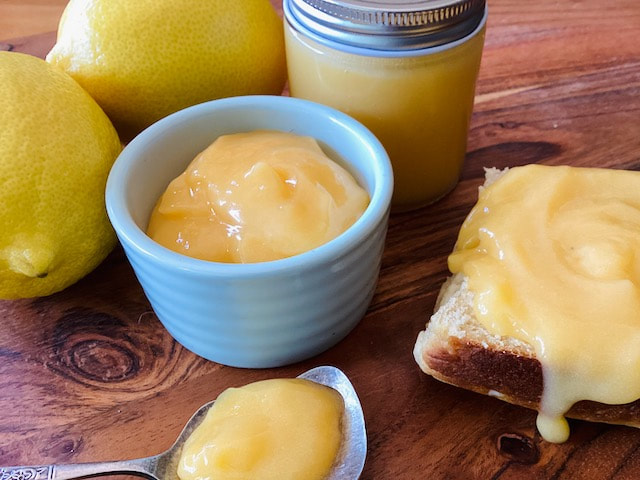|
Confession time: I don't think I've ever managed to leave a country town or weekend market without buying a jar of preserve. Chutney, mustard, jam, I am powerless to resist. The undisputed Australian champion of all jarred preserves has to be lemon curd, aka lemon butter. And as it's peak lemon season right now, I need no further excuse to make a batch of curd myself. I'm sharing my trusty old reliable recipe that I've been using for lemon and passionfruit butter for decades. Its exact provenance is lost but I can tell you it's a combination of recipes from the CWA, my time in the Ritz Carlton pastry kitchen, and personal tweaks I've made over the years. Makes approx 400ml lemon curd Prep Time: 10 min; Cook Time: 10-15 min. Ingredients: 6 egg yolks 1 cup (220g) caster sugar 80g unsalted butter, chopped coarsely 1 tbsp finely grated lemon rind 2/3 cup (180ml) lemon juice (this is the juice of about 3 lemons depending on size) Method: Prepare your jars: This recipe makes about 400ml lemon curd so you'll need jars that hold that amount. You can use several small jars or one large. In order for the curd to keep for a fortnight in the fridge it's a good idea to sterilise the jars and lids first. To do this, place them in a heat-proof container or bowl and cover them with boiling water. Leave for 5 mins then use oven mitts or a tea towel to remove them from the hot water and place them upside down in your dish drainer to air dry while you make the lemon curd. Mix ingredients: Whisk egg yolks and sugar in a large, heatproof glass mixing bowl until combined. Add in all the remaining ingredients and stir to combine using a wooden spoon or spatula. Cook over a double boiler**: Grab a small-medium saucepan - one that the bowl sits on steadily and snugly. ⅓ fill it with water. Place the saucepan on the stove and turn the heat on med-high and then bring to a simmer. Then place your mixing bowl with the mixed ingredients on top of the saucepan - make sure the water is not touching the bottom of the bowl!. Cook, stirring continuously, over low heat, about 10-15 mins or until mixture changes from thin and runny to thick and glossy, and easily coats the back of a wooden spoon. Check water levels in the saucepan underneath intermittently and make sure you keep the water at a steady simmer. An easy test to see if your curd is ready is to cover the back of the wooden spoon with the lemon curd then use a teaspoon (or your finger) to scrape down the middle of the curd-coated wooden spoon. If it holds the shape without dripping off too quickly, it's ready. Remove the bowl from the saucepan immediately and place it on a heat proof work surface. Give the curd a last good stir for 10-20 seconds. Strain: Place a fine sieve over a jug or bowl and pour the curd into the sieve. Use your wooden spoon to coax it through the sieve into the jug below. Discard the bits of zest left behind in the sieve. Pour hot curd into your sterilised jars and twist the lids on tight to seal immediately. Label and date jars when cold then pop them in the fridge. Store lemon curd in the fridge for up to 2 weeks. **Suspending a mixing bowl over a pot of simmering water is called double boiling and is used when something needs to be cooked gently and slowly. It's by no means essential but it means that you're ensuring your curd won't overheat and turn into lemony scrambled eggs. PIMP MY RECIPE Try making this with other citrus fruits such as lime, blood orange or regular orange. For a passionfruit version, stir the flesh and seeds into the lemon curd directly after straining your curd, then pour the curd into your sterilised jars. USES FOR LEMON CURD Lemon bars, lemon meringue pie, pavlova, scones, hot cross buns. USES FOR LEFT OVER EGG WHITES Refrigerate and use within 3 days. Use them to make meringue, add to omelette mix or make royal icing.
0 Comments
Your comment will be posted after it is approved.
Leave a Reply. |
Categories
All
Archives
January 2024
|


 RSS Feed
RSS Feed